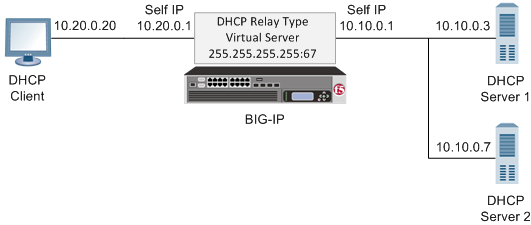Applies To:
Show Versions
BIG-IP AAM
- 13.1.5, 13.1.4, 13.1.3, 13.1.1, 13.1.0
BIG-IP APM
- 13.1.5, 13.1.4, 13.1.3, 13.1.1, 13.1.0
BIG-IP Link Controller
- 13.1.5, 13.1.4, 13.1.3, 13.1.1, 13.1.0
BIG-IP Analytics
- 13.1.5, 13.1.4, 13.1.3, 13.1.1, 13.1.0
BIG-IP LTM
- 13.1.5, 13.1.4, 13.1.3, 13.1.1, 13.1.0
BIG-IP AFM
- 13.1.5, 13.1.4, 13.1.3, 13.1.1, 13.1.0
BIG-IP PEM
- 13.1.5, 13.1.4, 13.1.3, 13.1.1, 13.1.0
BIG-IP DNS
- 13.1.5, 13.1.4, 13.1.3, 13.1.1, 13.1.0
BIG-IP ASM
- 13.1.5, 13.1.4, 13.1.3, 13.1.1, 13.1.0
Overview: Managing IP addresses for DHCP clients
When you want to manage Dynamic Host Configuration Protocol (DHCP) client IP addresses, you can configure the BIG-IP® system to act as a DHCP relay agent. A common reason to configure the BIG-IP system as a DHCP relay agent is when the DHCP clients reside on a different subnet than the subnet of the DHCP servers.
Before configuring the BIG-IP system to act as a DHCP relay agent, it is helpful to understand some BIG-IP system terminology:
| BIG-IP object type | Definition |
|---|---|
| BIG-IP pool member | A DHCP relay target (such as a DHCP server or BOOTP server). This is the dynamic address server to which the BIG-IP system forwards unicast requests. |
| BIG-IP virtual server | A BIG-IP system address on the listening VLAN |
| BIG-IP VLAN assigned to a virtual server | A listening VLAN, controlled on a per-virtual server basis |
About the BIG-IP system as a DHCP relay agent
A BIG-IP® virtual server, configured as a Dynamic Host Configuration Protocol (DHCP) type, provides you with the ability to relay DHCP client requests for an IP address to one or more DHCP servers, available as pool members in a DHCP pool, on different +virtual local area networks (VLANs). The DHCP client request is relayed to all pool members, and the replies from all pool members are relayed back to the client.

A sample DHCP relay agent configuration
For example, a DHCP client sends a broadcast message to the destination IP address 255.255.255.255, which is the destination address configured on the virtual server. A DHCP type virtual server automatically uses port 67 for an IPv4 broadcast message or port 547 for an IPv6 broadcast message. The BIG-IP virtual server receives this message on the VLAN with self IP address 10.20.0.1 and relays the DHCP request to all DHCP servers: 10.10.0.3 and 10.10.0.7.
All DHCP servers provide a DHCP response with available IP addresses to the BIG-IP virtual server, which then relays all responses to the client. The client accepts and uses only one of the IP addresses received.
Alternate configuration
If the DHCP client subnet includes a BIG-IP system that serves as a hop to the BIG-IP relay agent, you must perform two additional configuration tasks:
- You must configure the BIG-IP relay agent to relay the client DHCP requests to the DHCP servers without losing the originating subnet (source) IP address. This originating source IP address is typically a self IP address of the BIG-IP system that resides on the client subnet. You configure the BIG-IP relay agent to preserve the originating source IP address by creating a SNAT that specifies the originating self IP address as both the origin address and the translation address. A SNAT configured in this way prevents the BIG-IP relay agent, before sending the DHCP broadcast message to the DHCP servers, from translating the source IP address of the incoming DHCP request to a different address.
- You must add a route (to the BIG-IP relay agent) that specifies the originating source IP address as the destination for DHCP responses. The DHCP servers use this route to send their responses back through the BIG-IP relay agent to the clients.
Task summary
You configure the BIG-IP system to act as a Dynamic Host Configuration Protocol (DHCP) relay agent by creating a pool of DHCP servers and then creating a virtual server to manage DHCP client broadcast messages.
Task list
Creating a pool of DHCP servers
Creating a DHCP type virtual server
Implementation result
The BIG-IP® system is configured to manage Dynamic Host Configuration Protocol (DHCP) client IP addresses, using a DHCP type of virtual server to manage DHCP client broadcast messages.





